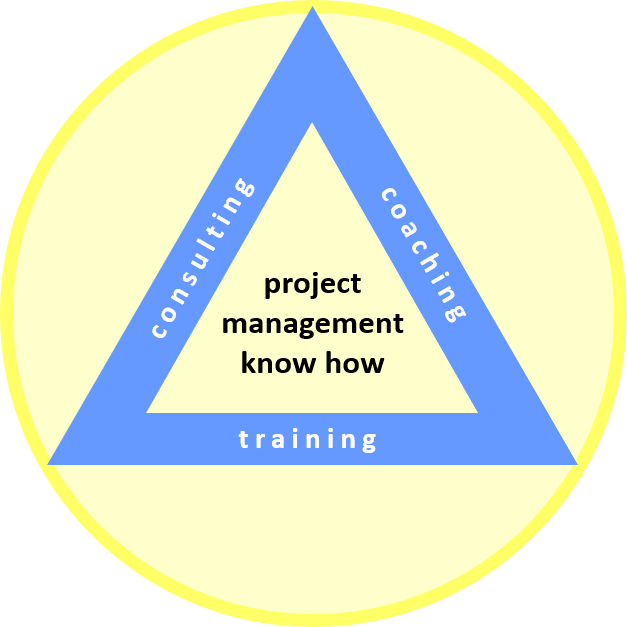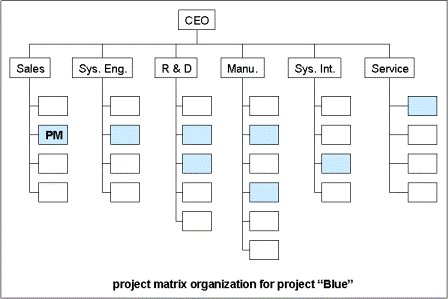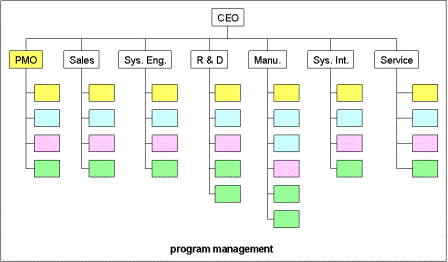- Home
- Project Portfolio
- Program Management
Program Management
Published: 2009-09-14
Last updated: 2022-03-20
We define program management as a set of methods an organization can use to enable management of projects that are similar in terms of scope. As such, it is a special case of multi project management which was defined as a set of methods to manage multiple projects.
In multi project management, those multiple projects "only" share general resources of the organization, such as business administration, accounting services, IT services, financing services, HR services, a library, etc. Based on our definition, the projects of a program have essential parts of their scope in common.
Let us look at an example of a construction company that is involved in constructing large office buildings, factory buildings for car manufacturing, and private homes in areas of new community development. The projects of any one of these areas, e.g. large office buildings, have essential parts of their scope in common; thus, the company could apply program management methods in order to enable management of each individual office building project.
Typically, they will use the project matrix organization for managing programs of projects.
In managing programs, we often use a project management office (PMO) as pool of project managers, schedulers, contract managers, and risk managers. In addition, there will be a pool of sales representatives, systems engineers, designers and developers, system integrators, and service engineers for significant parts of those projects that belong to the same program of projects.
In that sense, program management becomes a rigorous and comprehensive application of the project matrix organization covering all essential parts of the projects of that program.
Consequently, we will encounter similar problems as with project matrix organizations in general (refer to sub-section Multi Project Management):
- colleagues working in "multi-tasking mode"
- work overload with too many projects
Clear and unique allocation of resources to projects of such a program can help to avoid these problems (as indicated in the above picture).
In programs of projects, we want to make sure that we transfer lessons learned of one project to the other ones of that same program. These lessons learned cover all phases of the project management process. Here, we would like to point out two areas in which transfer of lessons learned across all projects of one program are most helpful.
Effort Estimation
Since the projects of a program have essential parts of their scope in common a significant number of work packages in each of the projects will be similar, if not the same, to those of the other projects of that program; e.g. in a program of private home construction projects, we would find work packages like "mount windows", "lay tiles", "install sockets", "install switches", "pull cable", "install kitchen appliances", "install bathroom appliances", etc. If it is for private home construction there might be differences in material types and costs. But in terms of effort and duration, we usually can conclude from effort and duration per unit to effort and duration for the whole project, under the condition we know the number of units for the whole project (further details in sub-section Effort Estimation; here, it is the combination of multiplication method and analogy method; function point method is based on the same principles).
How do we know effort and duration per unit? We know these values from other projects of the same type or program we have done earlier already.
This describes the process of knowledge transfer that we use in program management. Apparently, we need to involve the experts of all those work packages that are similar from project to project.
Risk Management
Another area in which we can benefit from transferring lessons learned from one project to similar ones is risk management. Throughout each project, we conduct periodical risk analysis workshops where we identify possible risk events, probability and impact, and preventive or corrective actions. Projects of a program have similar scope; thus, we expect similar risks for these projects. By collecting actual data about similar risks across a program of projects we will be able to apply the rules of statistics to every risk that is common to most or all of those projects. Estimation of probability and impact become more reliable.
Return to Project Portfolio Management
Return from Program Management to Home Page
|
|
|



Your Comments
Have your say about what you just read! Leave me a comment in the box below.